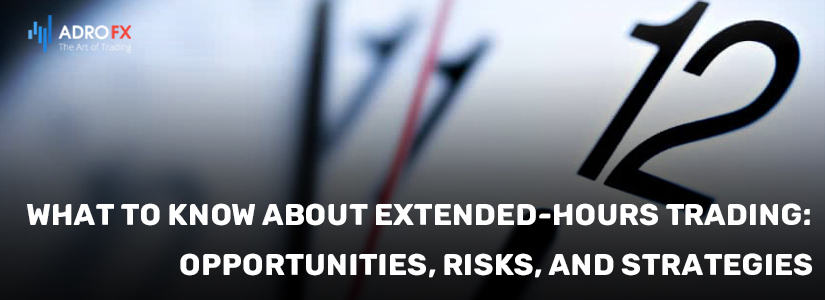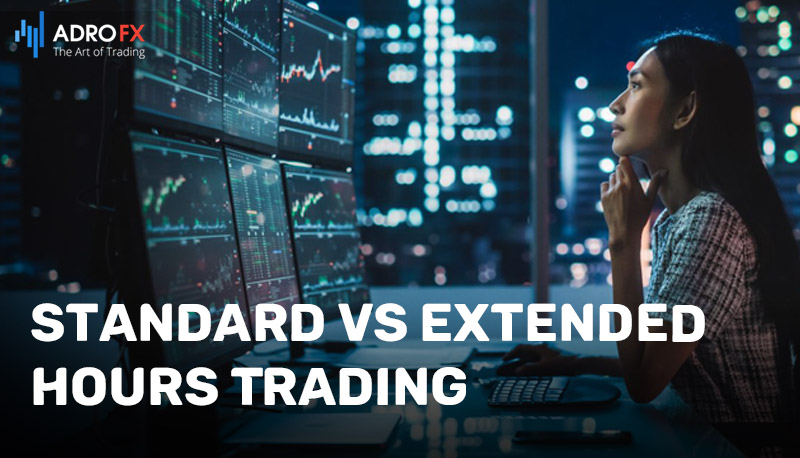What to Know About Extended-Hours Trading: Opportunities, Risks, and Strategies

The world of financial markets operates on a relentless schedule, with most stock exchanges adhering to a standard trading day that runs from 9:30 AM to 4:00 PM Eastern Time in the United States. However, the realm of extended hours trading exists as a fascinating parallel universe for traders seeking opportunities when the primary exchanges have closed their doors. In this article, we explore what extended hours trading entails and why it matters. We delve into the differences between standard and extended hours trading, the technical nuances, and associated risks, and provide valuable tips to help traders navigate this uncharted territory. So, fasten your seatbelt as we embark on a journey through the world of extended-hours trading.
What Are Extended Hours in Trading?
Extended trading hours refer to periods when the primary stock exchanges are closed for regular trading. In the United States, the main trading session typically runs from 9:30 AM to 4:00 PM ET. There are two categories of extended-hours trading:
- After-Hours Session
This period takes place shortly after the regular market closes. While the specific hours may vary among brokers, it typically runs from 4:00 PM to 8:00 AM ET. - Pre-Market Session
The pre-market session occurs between 7:30 AM to 9:25 AM ET, just before the main market opens. Notably, some brokers, like Robinhood, offer pre-market orders from 9:00 AM to 9:30 AM ET, and after-hours trading up until 6:00 PM.
Since the primary markets are usually closed during these extended hours, most brokers rely on Electronic Communications Networks (ECNs) or Electronic Stock Exchanges to facilitate trading. Extended hours trading holds significance because it often sets the tone for market movements when the main market opens.
Why Extended Hours Matter
Extended hours trading is crucial for several reasons:
- Earnings Announcements
Companies frequently release their earnings reports before or after the regular market hours to give investors time to digest the information. - Mergers and Acquisitions (M&A)
M&A deals can lead to high volatility in affected stocks, so companies often announce them during extended hours to manage market reactions. - Analyst Calls
Many analysts release their recommendations before the market opens, influencing early trading. - Management Changes
Major executive appointments or changes are often disclosed after the market closes or before it reopens. - Investigations
Companies typically reveal ongoing investigations during extended hours to ensure transparency.

Differences Between Standard and Extended Hours Trading
Several key differences exist between standard (regular) and extended-hours trading:
Types of Orders
During regular trading hours, you can execute all types of orders, including market orders, limit orders, and stop orders. However, in extended hours, many brokers only accept limited orders. Robinhood, for example, accepts all order types but executes them when the main market opens.
Available Stocks
Most brokers offer thousands of stocks and exchange-traded funds (ETFs) during regular hours. In extended hours, some brokers limit the number of assets available for trading. Schwab, for instance, restricts extended hours trading to companies listed on the New York Stock Exchange (NYSE) and Nasdaq.
Order Sizes
While you can buy as many shares as you want during regular hours, online brokers often impose limits on the number of shares you can buy during extended hours. Schwab, for example, caps orders at 25,000 shares in a single order.
Liquidity
Liquidity, or the flow of money in and out of the market, varies between regular and extended hours. The regular session typically has high liquidity due to the participation of numerous investors, ensuring faster order execution. In contrast, extended-hours trading faces lower liquidity because many large investors remain inactive.
Technical Differences
Beyond these differences, there are technical distinctions as well. In the regular session, trading takes place through market makers in exchanges like the NYSE and Nasdaq, whereas extended hours trading occurs through the ECN market. Furthermore, various time limits are available in the regular session, including Day, GTC (Good 'Til Canceled), IOC (Immediate or Cancel), and FOK (Fill or Kill), whereas orders in extended hours are typically good for the entire session.
Risks of Extended-Hours Trading
Engaging in extended-hours trading carries inherent risks that traders should be aware of. These risks stem from the unique characteristics of trading during times when the main markets are closed. Here are some key risks associated with extended hours trading:
- Reduced Liquidity
Extended hours trading typically sees lower participation from large institutional investors, leading to reduced liquidity in the market. This can result in wider bid-ask spreads and difficulty executing large orders at desired prices. - Higher Volatility
With fewer market participants, price swings in extended hours trading can be more pronounced. Traders may encounter unexpected and rapid price movements, which can lead to significant gains or losses. - Limited Access
Not all assets are available for trading during extended hours. Many stocks, for example, are restricted to regular market hours. This limitation can constrain your ability to diversify your trading portfolio during extended hours. - Market Orders
During extended hours, market orders may be executed at prices that significantly differ from the last closing price. Traders who rely on market orders in these conditions may experience unfavorable fills. - News Sensitivity
Extended hours trading is often influenced by news releases and events that occur outside regular trading hours. Unexpected news can lead to rapid price changes, and traders may have limited time to react effectively. - Technological Risks
Extended hours trading often involves electronic communication networks (ECNs) and different trading systems. Technical issues or disruptions in these systems can disrupt trading and impact order execution. - Extended Settlement Times
The settlement of trades executed during extended hours may take longer to complete. This extended settlement period can tie up capital and limit the flexibility of traders.
Traders should consider these risks carefully and develop a risk management strategy that aligns with their trading goals and risk tolerance when participating in extended-hours trading. 
Tips for Using Extended Hours
Extended hours trading is a realm filled with both promise and peril. To harness its potential and mitigate its challenges, consider the following guidelines:
- Before diving in, it's crucial to understand the inherent risks of extended-hours trading. These include reduced liquidity, heightened volatility, and limited asset availability. Acknowledging these obstacles is the initial step toward effectively managing them.
- Selecting the right broker is paramount. Not all brokers support extended-hours trading, and those who do may have differing policies and constraints. Therefore, thorough research is essential to find a broker aligned with your trading objectives, and offering the services and assets you require.
- Define your objectives clearly. Whether your aim is to capitalize on price gaps, react swiftly to news events, or pursue specific strategies during extended hours, a well-defined goal will guide your actions.
- Effective risk management is non-negotiable. Implement sound practices like setting stop-loss and take-profit orders. Given the elevated volatility, meticulous risk management is crucial.
- Asset selection is pivotal. Some stocks and ETFs may not be available for trading during extended hours, and liquidity can vary greatly among assets. Choose wisely.
- Stay informed about events and news outside regular market hours. Extended hours trading is highly susceptible to external factors. Keep a watchful eye on relevant news, earnings reports, and economic releases to anticipate potential market movements.
- When executing trades in extended hours, consider using limit orders instead of market orders. This approach ensures your trades are executed at your desired price levels, minimizing the impact of rapid price fluctuations.
- If you're new to extended-hours trading, make good use of a demo account provided by your broker. This will allow you to practice and become comfortable with the nuances of trading outside regular market hours.
- Avoid overcommitting to large positions during extended hours. Some brokers may impose limits on the number of shares you can trade. Vigilantly manage your position sizes to control risk.
- Technical preparedness is crucial. Ensure your trading platform and equipment are reliable and ready for extended-hours trading. Technical issues can disrupt your trading activities and lead to losses.
- Tailor your trading strategy to the distinctive nature of extended-hours trading. Whether you choose swing trading, position trading, or scalping, select a strategy that suits the conditions.
- Keep meticulous records of your extended-hours trades. Analyze your performance and identify areas for improvement as you gain experience.
By adhering to these guidelines, traders can confidently navigate extended-hours trading, making the most of the opportunities that emerge when the primary markets are closed.
Conclusion
In the fast-paced world of finance, extended-hours trading emerges as a dynamic and essential arena. This alternative trading universe, encompassing after-hours and pre-market sessions, offers traders unique opportunities to gain an edge in the market. By allowing for early access to crucial information, extended-hours trading often sets the tone for market movements when the primary market reopens. Yet, this world is not without its perils, including reduced liquidity, increased volatility, and limited asset availability. As such, traders must tread carefully, following a set of prudent guidelines that include understanding the risks, choosing the right broker, and employing effective risk management strategies. With the knowledge and insights gained from this article, traders can confidently navigate the extended-hours trading landscape, harness its potential, and mitigate its challenges, making the most of the opportunities that arise when the primary markets are closed.

About AdroFx
Established in 2018, AdroFx is known for its high technology and its ability to deliver high-quality brokerage services in more than 200 countries around the world. AdroFx makes every effort to keep its customers satisfied and to meet all the trading needs of any trader. With the five types of trading accounts, we have all it takes to fit any traders` needs and styles. The company provides access to 115+ trading instruments, including currencies, metals, stocks, and cryptocurrencies, which make it possible to make the most out of trading on the financial markets. Considering all the above, AdroFx is the perfect variant for anyone who doesn't settle for less than the best.









